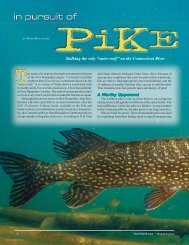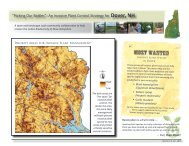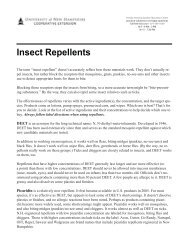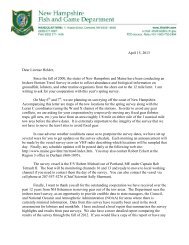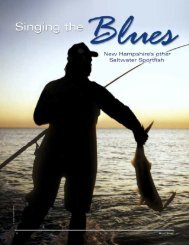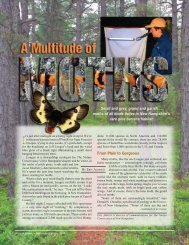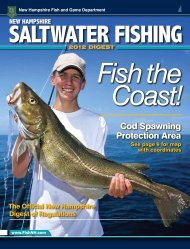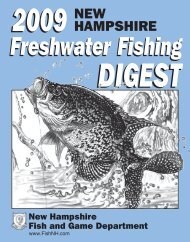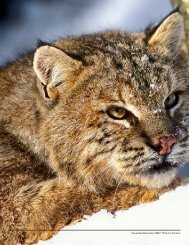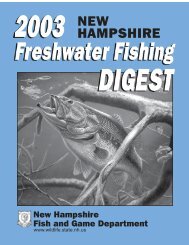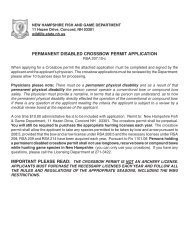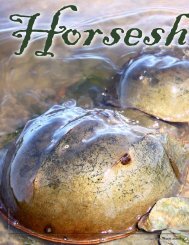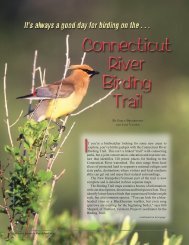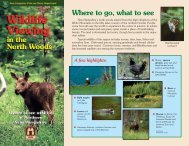On the Atlantic Flyway - New Hampshire Fish and Game Department
On the Atlantic Flyway - New Hampshire Fish and Game Department
On the Atlantic Flyway - New Hampshire Fish and Game Department
- No tags were found...
Create successful ePaper yourself
Turn your PDF publications into a flip-book with our unique Google optimized e-Paper software.
O n t h e<strong>Atlantic</strong><strong>Flyway</strong>Keeping track of <strong>New</strong> <strong>Hampshire</strong>’s waterfowlis an international affair.<strong>On</strong>e of <strong>the</strong> best parts of fall is hearing <strong>the</strong> cacophony of honking,high-flying geese as <strong>the</strong>y pass overhead. Have you everwondered where that “V” of geese fly to in <strong>the</strong> fall, or where thoseducklings you watched last spring went after <strong>the</strong>y hatched? <strong>New</strong><strong>Hampshire</strong> has a wealth of waterfowl – many species of ducks <strong>and</strong>two populations of Canada goose migrants, as well asresident goose populations. Resident geese hatch <strong>the</strong>iryoung here <strong>and</strong> in <strong>the</strong> fall travel only as far as <strong>the</strong>yneed to in order to find open water <strong>and</strong> food (sou<strong>the</strong>rn<strong>New</strong> Engl<strong>and</strong> usually works out). The migrants are long-haul flyersthat travel many miles to reach here.Highway in <strong>the</strong> SkyTwo distinct migrant waterfowl populations wing <strong>the</strong>ir way over<strong>New</strong> <strong>Hampshire</strong> – <strong>the</strong> Maritime (North <strong>Atlantic</strong> Population) <strong>and</strong> <strong>the</strong><strong>Atlantic</strong> Population. The Maritime birds breed in eastern Canada’sprovinces of Labrador <strong>and</strong> <strong>New</strong>foundl<strong>and</strong> from June to August.Come fall, <strong>the</strong>se birds travel along our coastal waters, spending <strong>the</strong>winter on waters from Great Bay south to <strong>New</strong> Jersey. The <strong>Atlantic</strong>Population birds nest in far nor<strong>the</strong>rn Canada on Ungava Bay; <strong>the</strong>ytravel south through <strong>New</strong> <strong>Hampshire</strong> along <strong>the</strong>Connecticut River Valley on <strong>the</strong>ir way towinter quarters on <strong>the</strong> Chesapeake Bay.How do N.H. <strong>Fish</strong> <strong>and</strong> <strong>Game</strong>biologists keep track of thisw<strong>and</strong>ering wildlife? Theyby Julie Robinson <strong>and</strong>Edward Robinsonwork with o<strong>the</strong>r waterfowl biologists throughout North Americato manage waterfowl species. Because of <strong>the</strong>ir migratory nature,ducks <strong>and</strong> geese are a shared resource, so <strong>the</strong>y are managed collaborativelythroughout <strong>the</strong>ir range. Bird populations tend to travel <strong>the</strong>same routes every spring <strong>and</strong> fall as <strong>the</strong>y move from <strong>the</strong>ir breedingor wintering areas. These corridors are generallynorth to south <strong>and</strong> cross international boundaries.In order to better manage <strong>the</strong>se populations, <strong>the</strong>North American <strong>Flyway</strong> System was developed in1951 <strong>and</strong> continues to this day. The <strong>Flyway</strong> System consists offour distinct geographic areas: Pacific, Central, Mississippi <strong>and</strong><strong>Atlantic</strong>. Each flyway manages <strong>the</strong> waterfowl populations thattravel through it. Some waterfowl species, like scaup populations,travel across more than one flyway, so flyways will worktoge<strong>the</strong>r to manage <strong>the</strong>m. <strong>New</strong> <strong>Hampshire</strong> is part of <strong>the</strong> <strong>Atlantic</strong><strong>Flyway</strong>, which includes 17 states <strong>and</strong> 6 provinces along <strong>the</strong> Easternseaboard. Waterfowl biologists from state, provincial <strong>and</strong> federaljurisdictions meet annually to evaluate waterfowl populations,look at new research, review habitat needs <strong>and</strong> develop annualwaterfowl hunting regulations.How many Birds?Waterfowl management is, to some extent, a numbers game. Eachstate <strong>and</strong> province, in concert with <strong>the</strong> U.S. <strong>Fish</strong> & Wildlife Service<strong>and</strong> <strong>the</strong> Canadian Wildlife Service, collects biological data that isused to help evaluate annual <strong>and</strong> long-term population <strong>and</strong> habitatfluctuations <strong>and</strong> needs. <strong>Fish</strong> <strong>and</strong> <strong>Game</strong> biologists conduct annualsurveys that provide data on breeding <strong>and</strong> wintering populationsof waterfowl that spend a part of <strong>the</strong>ir lives here in our state. Thisinformation is combined with data from o<strong>the</strong>r states <strong>and</strong> provinces.For example, since 1952, all <strong>Atlantic</strong> <strong>Flyway</strong> states conduct a MidwinterInventory of coastal habitats during <strong>the</strong>first week of January. <strong>Fish</strong> <strong>and</strong> <strong>Game</strong> biologistsSeptember/October 2009 • Wildlife Journal
HUDSONBAY<strong>Atlantic</strong>PopulationWildlife Journal • September/October 2009UNGAVABAYMaritimePopulationATLANTICOCEANThe <strong>Atlantic</strong> <strong>Flyway</strong>is made up of twopopulations: <strong>the</strong>Maritime Population(which includes GreatBay’s winter waterfowl)hugs <strong>the</strong> coast,nesting in Labrador <strong>and</strong><strong>New</strong>foundl<strong>and</strong>; <strong>and</strong> <strong>the</strong><strong>Atlantic</strong> Population,which passes over<strong>New</strong> <strong>Hampshire</strong>’sConnecticut Rivervalley en route from<strong>the</strong> Chesapeake Bayto breeding grounds inUngava Bay.©Larry ye / dreamstime.com
©Lars christensen / dreamstime.comMallards (left) are <strong>the</strong>most common breedingduck in <strong>New</strong> <strong>Hampshire</strong>,<strong>and</strong> during <strong>the</strong> huntingseason are <strong>the</strong> mostcommon bird bagged.The numbers of Canadageese (right) continueto increase; <strong>the</strong> residentpopulation in <strong>the</strong> <strong>Atlantic</strong><strong>Flyway</strong> hovers aroundone million birds.fly transects at low altitudes <strong>and</strong> slow speed over GreatBay, <strong>the</strong> coastline, <strong>the</strong> Hampton/Seabrook marshes<strong>and</strong> <strong>the</strong> Isles of Shoals, counting <strong>the</strong> numbers ofdifferent wintering waterfowl species <strong>the</strong>y see. Since1952, biologists have counted an average of 4,600waterfowl each year during this aerial survey – about1,900 Canada geese, 1,300 black ducks, 200 mallards<strong>and</strong> 350 scaup.The survey has seen many shifts in bird populationssince it began in 1952, fluctuations due largely tohabitat changes. For example, <strong>the</strong> number of Canadageese observed has increased from about 1,700 birdsduring <strong>the</strong> 1960s to around 2,600 in recent years.In contrast, <strong>the</strong> number of black ducks has declinedfrom an average of 2,100 during <strong>the</strong> 1960s; now <strong>the</strong>irnumbers are closer to 850. Mallards have shown alarge increase, rising from an average of just 24 toabout 500 today. Greater scaup populations havemore than tripled in <strong>the</strong> past forty years, rising from200 to around 900 in recent years.To get a more complete picture of <strong>the</strong> state’swaterfowl populations, <strong>New</strong> <strong>Hampshire</strong> waterfowlbiologists also conduct an inl<strong>and</strong> waterfowl surveyin January <strong>and</strong> February. Established in 1988, <strong>the</strong>inl<strong>and</strong> survey provides data on wintering mallards,black ducks <strong>and</strong> Canada geese throughout <strong>the</strong> rest of<strong>the</strong> state. From this work, we know that, on average,4,400 mallards <strong>and</strong> 440 black ducks winter on openfresh water throughout <strong>the</strong> state. Canada geese aremore variable. Their numbers can range from 20 to3,500, depending on <strong>the</strong> severity of <strong>the</strong> winter <strong>and</strong> <strong>the</strong>amount of snowfall we receive each year. The geesewe see on inl<strong>and</strong> sites during <strong>the</strong> winter tend to befrom our resident population (not migrants).Duck FactoriesBiologists don’t just count ducks in <strong>the</strong> winter.Come spring, <strong>the</strong>y are once again out in <strong>the</strong> woods <strong>and</strong>wetl<strong>and</strong>s to survey breeding waterfowl populations.Breeding birds tend to return to <strong>the</strong> same wetl<strong>and</strong>seach year to nest. By surveying <strong>the</strong>se areas at <strong>the</strong>same time over many years, we are able to evaluateemerging trends.Our spring surveys are part of a much largerfederal effort to track breeding waterfowl. Since 1955,<strong>the</strong> U.S. <strong>Fish</strong> & Wildlife Service <strong>and</strong> <strong>the</strong> CanadianWildlife Service have conducted breeding surveys in<strong>the</strong> prairie pothole <strong>and</strong> parkl<strong>and</strong>s of <strong>the</strong> north-centralU.S. <strong>and</strong> Canada. These areas are considered <strong>the</strong>“duck factories” of North America. In addition, <strong>the</strong>two federal agencies also survey breeding habitatsfrom <strong>On</strong>tario to eastern Canada <strong>and</strong> Maine.For <strong>the</strong> last two decades, <strong>New</strong> <strong>Hampshire</strong> hasconducted breeding population studies in concert with10 <strong>Atlantic</strong> <strong>Flyway</strong> states. Put toge<strong>the</strong>r, this informationgives us regional statistics on waterfowl populations.Over <strong>the</strong> last 20 years, for example, mallardpopulations have remained fairly stable, while blackduck numbers have declined over time. Wood ducknumbers have increased, <strong>and</strong> Canada geese numbershave gone up significantly.Managing waterfowl species over a large l<strong>and</strong>scapecan be very complex <strong>and</strong> calls for cooperation on aninternational level. The <strong>Atlantic</strong> <strong>Flyway</strong> (<strong>and</strong> <strong>the</strong> o<strong>the</strong>rthree flyways) meet two times each year. <strong>On</strong>e is a technicalmeeting, where state <strong>and</strong> provincial waterfowlbiologists meet with <strong>the</strong>ir counterparts at <strong>the</strong> federallevel to discuss survey results <strong>and</strong> research needs <strong>and</strong>propose specific hunting regulations.10 September/October 2009 • Wildlife Journal
©richard thomas / dreamstime.com©usfws / gene niemenin photo©usfws / donna dewhurst photo ©john gill photoTo help evaluate hunting season lengths <strong>and</strong>number of birds to be harvested, state, federal <strong>and</strong>provincial biologists conduct b<strong>and</strong>ing efforts eachyear. B<strong>and</strong>ing data provides survival <strong>and</strong> distributionnumbers. Each year in <strong>the</strong> <strong>Atlantic</strong> <strong>Flyway</strong> alone,some 25,000 Canada geese <strong>and</strong> 25,000 ducks areb<strong>and</strong>ed. <strong>New</strong> <strong>Hampshire</strong> b<strong>and</strong>s an average of 500resident Canada geese each year <strong>and</strong> around 300ducks, which include mallards, black ducks <strong>and</strong>wood ducks. During <strong>the</strong> fall hunting season, hunterswho harvest a bird with a leg b<strong>and</strong> are asked to calla 1-800 number <strong>and</strong> participate in a short survey.The information ga<strong>the</strong>red from hunters is includedin <strong>the</strong> North American b<strong>and</strong>ing database. Mosthunters underst<strong>and</strong> <strong>the</strong> importance of participatingin this survey <strong>and</strong> do not hesitate to call to report aharvested b<strong>and</strong>ed bird. Through this survey, we areable to estimate an annual survival rate <strong>and</strong> distributiondata. We have found that a few of our <strong>New</strong><strong>Hampshire</strong> wood ducks have been harvested as faraway as Georgia, Tennessee <strong>and</strong> <strong>the</strong> Carolinas.Wild Goose Chase<strong>New</strong> <strong>Hampshire</strong>’s most concentrated b<strong>and</strong>ingeffort happens in late June, when <strong>Fish</strong> <strong>and</strong> <strong>Game</strong>’s“Goose Crew” heads out throughout <strong>the</strong> state to b<strong>and</strong>geese. This group consists of state <strong>and</strong> federal biologists<strong>and</strong> a few volunteers; most have been helpingout since <strong>the</strong> effort began in 1991. B<strong>and</strong>ing occursduring <strong>the</strong> time that Canada geese molt <strong>the</strong>ir flightfea<strong>the</strong>rs each year (mid to late June) <strong>and</strong> are flightlessfor about 3 weeks until <strong>the</strong>ir new flight fea<strong>the</strong>rsgrow in. This coincides with <strong>the</strong> young of <strong>the</strong> yearbecoming flighted. The goose crew has become quiteproficient in <strong>the</strong>ir b<strong>and</strong>ing effort <strong>and</strong> since 1991 hasb<strong>and</strong>ed some 9,600 geese!The wild goose chase begins with biologistssetting up a funnel-shaped net structure into which<strong>the</strong>y can “herd” <strong>the</strong> geese. Because <strong>the</strong> geese cannotfly, people on shore <strong>and</strong> some in canoes work toge<strong>the</strong>rto direct <strong>the</strong> geese into <strong>the</strong> funnel. <strong>On</strong>ce <strong>the</strong> birds aresecure in <strong>the</strong> holding pen, <strong>the</strong>y are carefully h<strong>and</strong>led,b<strong>and</strong>ed <strong>and</strong> released. Biologists ga<strong>the</strong>r data on <strong>the</strong>The population of NorthAmerican wood duck(top) has completelyrebounded, <strong>and</strong> today it is<strong>the</strong> second most commonbreeding duck in <strong>New</strong><strong>Hampshire</strong>. Americanblack ducks (lower left)are often seen in summer<strong>and</strong> fall on beaver ponds;<strong>the</strong>y winter on Great Bay,along with greater scaup(lower right).Wildlife Journal • September/October 2009 11
With <strong>the</strong> aid of a funnelshapednet, flightlessgeese are rounded upby <strong>the</strong> <strong>Fish</strong> <strong>and</strong> <strong>Game</strong>“goose crew” in June.B<strong>and</strong>ing does not hurt<strong>the</strong> birds.birds’ age, sex <strong>and</strong> <strong>the</strong>number of young in abrood. A fair numberof previously b<strong>and</strong>edbirds are recapturedeach year, with someshowing up for 5-7years. The oldest todate was a 16-yearoldfemale that wasb<strong>and</strong>ed as a juvenile!B<strong>and</strong>ing doesnot hurt <strong>the</strong> birds<strong>and</strong> is an easy wayto get importantstatistics on our goosepopulation. <strong>New</strong><strong>Hampshire</strong>’s b<strong>and</strong>ingdata helped provide<strong>the</strong> documentationneeded to support<strong>the</strong> establishmentof <strong>the</strong> September resident Canada goose season innor<strong>the</strong>rn <strong>New</strong> Engl<strong>and</strong>.O<strong>the</strong>r b<strong>and</strong>ing efforts focuson mallards, black ducks <strong>and</strong> wood ducks. Biologistsuse a variety of capture methods, including confusiontraps, rocket nets <strong>and</strong> wood duck boxes (female woodducks are b<strong>and</strong>ed as <strong>the</strong>y incubate <strong>the</strong>ir eggs).©nhfg / julie robinson photo©nhfg / julie robinson photoThe Habitat ConnectionSurveys <strong>and</strong> b<strong>and</strong>ing efforts are important, butgood waterfowl habitat is just as vital. Waterfowlhunters have championed <strong>the</strong> effort to exp<strong>and</strong> waterfowlhabitat through <strong>the</strong> purchase of federal <strong>and</strong>state duck stamps. This money has been used over<strong>the</strong> years to purchase <strong>and</strong> manage waterfowl habitatthroughout North America. Here in <strong>New</strong> <strong>Hampshire</strong>,16 grants have been awarded through a competitiveprocess with o<strong>the</strong>r states. These grants have protected125,000 acres of wetl<strong>and</strong> <strong>and</strong> upl<strong>and</strong> buffer habitat.<strong>Fish</strong> <strong>and</strong> <strong>Game</strong> has been acquiring waterfowl habitatsince <strong>the</strong> late 1940s. However, it wasn’t until 1983,when <strong>the</strong> duck stamp was established, that revenueswere dedicated solely for waterfowl habitat management<strong>and</strong> requisition. A total of 4,236 acres of waterfowlhabitat has been acquired through this program,<strong>and</strong> today <strong>Fish</strong> <strong>and</strong> <strong>Game</strong> owns <strong>and</strong> manages 52Waterfowl Management Areas, which include nearly10,000 acres of habitat.<strong>Fish</strong> <strong>and</strong> <strong>Game</strong> works with many o<strong>the</strong>r dedicatedwaterfowl conservation organizations that are criticalpartners. The N.H. Waterfowl Association helpedcomplete five projects to protect 56 acres of habitat.Ducks Unlimited has worked with <strong>Fish</strong> <strong>and</strong> <strong>Game</strong> toacquire 913 acres of key habitat through eight projects.Many of <strong>the</strong>se wetl<strong>and</strong> habitats are managed throughwater level control <strong>and</strong> all have actively managedwood duck nest boxes. <strong>Fish</strong> <strong>and</strong> <strong>Game</strong> biologists havemaintained some 300 nest boxes throughout <strong>the</strong> statesince <strong>the</strong> 1940s.<strong>On</strong>e of <strong>the</strong> crowning jewels of <strong>the</strong> waterfowlconservation project has been <strong>the</strong> Great Bay ResourceProtection Partnership, a coalition of public <strong>and</strong>private conservation groups working toge<strong>the</strong>r toconserve critical habitats. This partnership worked for<strong>the</strong> past 15 years to secure over 5,300 acres of importantwetl<strong>and</strong> habitats with adjacent upl<strong>and</strong> buffersthroughout <strong>the</strong> Great Bay watershed. These l<strong>and</strong>s areespecially important in <strong>the</strong> face of an ever-increasinghuman population throughout <strong>the</strong> Great Bay area <strong>and</strong><strong>the</strong> importance of <strong>the</strong> estuary’s waterfowl breeding<strong>and</strong> wintering grounds.So <strong>the</strong> next time you watch a “V” of geese fly by orare lucky enough to see a mo<strong>the</strong>r duck with her ducklings,remember that many dedicated individuals <strong>and</strong>groups are working toge<strong>the</strong>r to make <strong>New</strong> <strong>Hampshire</strong>a great place for ducks <strong>and</strong> geese...<strong>and</strong> youJulie Robinson is a wildlife biologist <strong>and</strong> Small<strong>Game</strong> Project Leader for N.H. <strong>Fish</strong> <strong>and</strong> <strong>Game</strong>. EdRobinson is <strong>Fish</strong> <strong>and</strong> <strong>Game</strong>’s Waterfowl Biologist.12 September/October 2009 • Wildlife Journal



